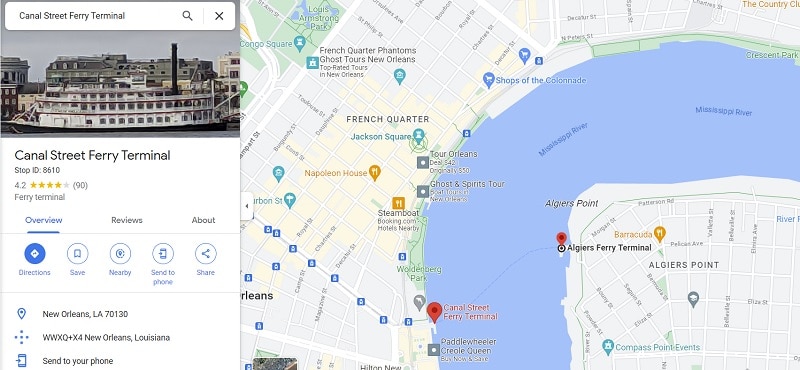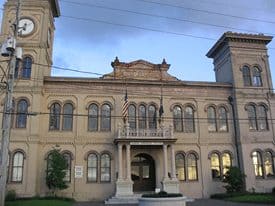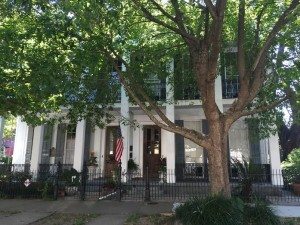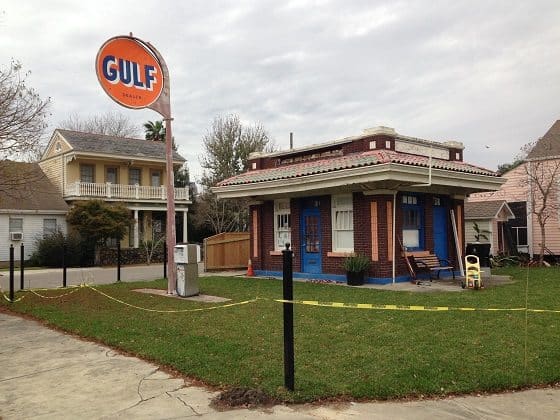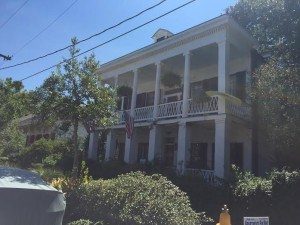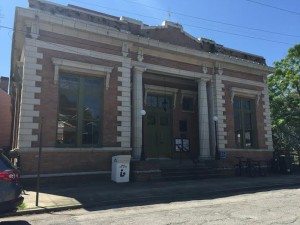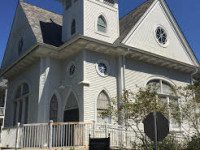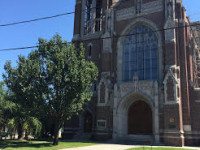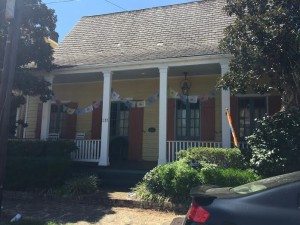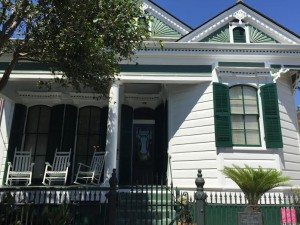This post tells you about how to visit the historic neighborhood of Algiers Point, New Orleans' second oldest neighborhood.
We include information on taking the famous ferry, what to see there, and suggestions for places to eat and drink.
HOW TO GET TO ALGIERS POINT
Just across the river from the French Quarter, Algiers Point is best reached by ferry at Canal Street, next to the Audubon Aquarium.
The ride offers stunning views of the New Orleans skyline. It costs $2 each way ($1 for seniors 65+ and children 2 and under are free).
The ferry will take you from the Canal Street Ferry Terminal and drop you off at the Algiers Ferry Terminal, a ferry landing that sits on the levee of Algiers Point.
Algiers Ferry Schedule:
On Mondays-Thursdays, the ferry runs to Algiers Point every 15 minutes at a quarter until and a quarter after the hour.
The first ferry leaves at 6 am and the last at 9:45 pm.
On Fridays, ferries run from 6 am - 11:45 pm; Saturdays, 10:30 am until 11:45 pm and Sundays from 10:30 am until 9:45 pm.
For exact times, check the official schedule.
If you are driving, it is a quick ride over the Crescent City Connection. Click here for driving directions.
A BRIEF HISTORY OF ALGIERS POINT
Algiers was founded on the West Bank of the Mississippi River in 1719, a year after New Orleans was founded.
Initially, this riverfront area was called Kings Plantation and it was where enslaved Africans were held after their arrival into the region before they were ferried to New Orleans.
When the Spanish gained control of Algiers, they sold off much of the property to private owners, and plantations sprung up.
After the Louisiana Purchase of 1803, Algiers gained a more diverse population, including Americans, Germans, Irish, and Italians.
Industry in this neighborhood included shipbuilding, lumber, wax, sugar, coal depots, and stockyards.
In the 1850s Algiers became a major hub in the railroad industry, where freight and passengers were moved across the Mississippi River on barges.
In 1895 a great fire destroyed about 200 homes, including the Duverje Plantation house which had been used as the Courthouse.
WHAT TO SEE AND DO IN ALGIERS POINT
Stop 1 - Algiers Ferry
Since 1827 the Algiers Ferry has been a city-run means of public transportation.
The Louisiana Legislature awarded August Coycault and Barthelemy Gosselin a contract to operate a steam ferry from the foot of Patterson Street on the west bank to Jackson Square on the east bank.
Two other lines were added bringing passengers from de la Ronde Street in Algiers to St. Louis Street in the French Quarter and from Verret St. to Esplanade Ave.
In 1952, the Greater New Orleans Bridge opened thus lessening the need for ferry service
Today there are two ferries that leave from the Canal Street dock. These ferries are the 4th busiest ferries in the United States.
Stop 2 - Algiers Courthouse on Morgan Street
This impressive building you see before you was built in 1896 to replace the Duverje Plantation house that had served as the court and had burned down the year before.
This building was designed by Linus Brown and Alonzo Bell in the Richardsonian Romanesque style.
This building is the 3rd oldest continuously used courthouse in the State of Louisiana.
Services include small claims court, access to property ownership information, voter registration and absentee balloting, marriage licenses, and weddings, and more.
Stop 3 - Canal Commercial Trust and Savings Bank - 501 Patterson Drive
This neoclassical-style bank was built in 1907 and designed by prominent New Orleans architect Emile Weil.
Weil also designed many theaters, churches, and banks from Texarkana to Pensacola in the early 1900s.
A merger between Canal Bank (1831) and Citizens Bank of Louisiana (1833) created the Canal Commercial Trust and Savings Bank in 1924.
Canal Commercial Bank failed in 1933, and its assets became part of the National Bank of Commerce in New Orleans – also known as First NBC.
Stop 4 - Seger/Rees House at 405-407 Delaronde St.
This magnificent two-family home was built in 1850 for Augustin Seger and Thomas Rees, who made their living in the transportation industry on the sea and by rail.
Built in the Greek Revival style, this type of house known as a double gallery house, is named for the two front porches.
The live oak on the side of the home is estimated to be 200 years old.
Stop 5 - Gulf Gas Station at 446 Pelican Ave.
From its beginning in 1929 until its closure in 1990, the Gulf Gas station was the longest continually operated gas station in the entire South of the U.S.!
It can be seen in the background of a scene in the movie Ray, about musician Ray Charles.
When the gas station closed down, it became Gulf Pizza, which had good pizza a cult following and! It too is now closed.
Stop 6 - Mount Olivet Episcopal Church at 530 Pelican Ave.
The parish of The Mount Olivet Episcopal Church was founded in 1846.
The building before you is the second church on this site as the first was completely destroyed by fire in 1866.
With its wooden features such as the pointed arch windows, this church is built in the Carpenter Gothic Revival style.
The plaque dating the church as 1854 is not for this current building.
Stop 7 - Vallette House at 705 Pelican Ave.
This two-story center hall dwelling was built in 1848 for Francois Vallette, who was born in Belle Chase in Plaquemines Parish.
He moved to Algiers where he became very successful with the Vallette Drydock Company.
During the Civil War, Vallette feared that the Union Army would commandeer his shipyards so he dynamited them, sacrificing his business to prevent helping the enemy.
Later, the Barrett family operated a funeral parlor out of this building.
Stop 8 - Algiers Point Branch Library (also known as the Hubbell Branch) at 725 Pelican Avenue.
According to their website, this library is the oldest public library in New Orleans opening on December 28, 1907.
Andrew Carnegie donated money to open five libraries in New Orleans of which only two are still open – the Algiers Point branch and the Napoleon Avenue library located in the neighborhood of Uptown.
This branch library was closed in 1966 when a newer Algiers library was built 4 miles away.
Cita Dennis Hubbell organized a group of volunteers who fought to get the Italianate structure reopened to service the community.
Their hard work was rewarded as the library reopened in 1975 with over 20,000 books!
After her death in 2001, the library was named the Cita Dennis Hubbell Branch Library.
Stop 9 - “Algy Theater” at 445 Vallette Street
This incredibly preserved Art Deco-style theater was built in 1940.

In 1993, this building was bought by Mark Rosenbaum, who had been awarded a grant by the Louisiana Division of the Arts to establish the first privately owned glassblowing studio in the state of LA.
Stop 10 - Trinity Evangelical Lutheran Church at 620 Eliza Street
In June 1875, it was decided that a new Lutheran Congregation was needed in the Algiers neighborhood.
The first service was held in a hotel belonging to John Hughes.
A church was built in the amazingly short time of 10 weeks and the congregation moved into it.
This present church was built in 1911, right next door to the older building to provide a larger house of worship for the growing German population.
The building has Gothic Revival details and incredible art glass windows.
Stop 11 - Holy Name of Mary Church at 400 Verret Street
This parish was originally established in 1848 in a much smaller building on Morgan Street.
A growing parish drove a need to make a bigger church so this building was built in 1929.
This brick Gothic-style building has over 75 stained glass windows, many of which were created in Munich Germany.
Stop 12 - Philip Foto’s Folly Theater, 501 Opelousas Avenue
Philip Foto’s Folly Theater was opened in 1915 and entertained residents with concerts, vaudeville acts, and silent films.
This theater was frequented by Emmet Hardy and “Papa” Jack Laine’s Reliance Band.
By 1920 the theater was upgraded from holding 2000 people instead of its previous 900.
This building was later called The Metropolitan Tabernacle and was occupied by the First Baptist Church of Algiers.
Damage during Katrina caused the congregation to move to Walker, Louisiana.
Stop 13 - New Orleans Fire Department at 425 Opelousas Avenue
Built in 1925, the current firehouse replaced an earlier station. Since 1897, there has been a fire station on this site.
With the Big Fire of 1895 in Algiers Point, fire stations were a necessity. But they served another purpose as well.
With the growth of jazz in New Orleans, firehouses were used as social halls for live bands and dances.
Stop 14 - Creole Cottage at 511 Sequin Street
Built in 1856 as a convent for the Sisters of Mount Carmel, this structure is a wonderful example of what is known as a 'creole cottage.'
It has a roof that slopes toward the sidewalk and the front openings are matched with openings in the back with the hope that this arrangement might catch a breeze.
Stop 15 - Behrman House at 228 Pelican Avenue
This house was built in 1896, just after the great fire of 1895. This home has all the finely carved details of an Eastlake-styled home.
Martin Behrman was born in New York, but his family moved to Algiers when he was a baby.
He was New Orleans’ mayor for almost 17 years (1904-1920, 1925-1926).
His most famous quote is about closing the city’s vice district named Storyville in 1917.
He claimed, “You can make it illegal, but you can’t make it unpopular.” Martin Behrman died at the beginning of his 5th term in 1926.
Old Point Bar - 545 Patterson Drive.
An Algiers Point institution. Numerous movies have been filmed here at this dive bar in a historic building.
There's live music every night and cheap cold drinks!
Congregation Coffee - 240 Pelican Ave.
Great cold brew coffee on a hot day and seats outside to relax. Kid-friendly!
Tout de Suite Cafe - 347 Verret St.
Some say this is the best breakfast in New Orleans and worth the ferry ride over. Known for their Atchafalaya (crawfish etouffee over creamy stone-ground grits with two eggs).
Tavolino - 141 Delaronde St.
Steps away from the ferry you can get a fantastic pizza made in the typical Roman style. It's even rated in the Zagat food guide, that's how good it is.
Crown and Anchor Pub - 200 Pelican Avenue.
Near the ferry, this English-style pub is cozy and known for its 'proper' gin and tonics.
Be sure to check out:
- Our calendar of guided walking tours of New Orleans.
- Our full list of self-guided New Orleans tours and neighborhood guides.





